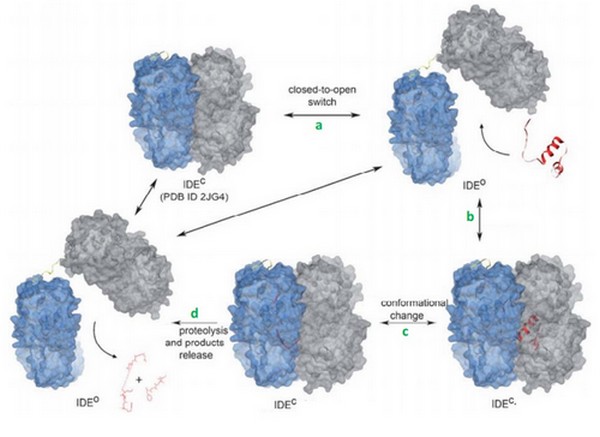Sandbox Reserved 972
From Proteopedia
(Difference between revisions)
| Line 9: | Line 9: | ||
===Exosite: an essential element for the catalysis=== | ===Exosite: an essential element for the catalysis=== | ||
| - | + | Previous studies reveal that IDE uses an exosite to interact with the N-terminal end of its substrate<ref>doi: 10.1074/jbc.M701590200</ref>. This exosite is completely different from the catalytic site, but it is an essential component for the substrate hydrolysis. Actually, it plays a role in the docking of substrates on IDE. Actually, when substrates arrive, they first bind to the exosite and then, they are translocated to the catalytic site. They have to change their conformation<ref> doi: 10.1038/nature05143</ref> in order to access to the catalytic site. It was also observed that the binding of bradykinin occurs at the exosite and not the catalytic site. | |
===Catalytic mechanism=== | ===Catalytic mechanism=== | ||
| - | + | IDE can switch between its open and its close state. In the close state, IDE can not bind a substrate but it can hydrolyze it if it was already binding. In the other hand, in the open state, IDE can bind a substrate but it is less active because the catalytic site is not completly close. | |
| - | + | ||
The catalytic mechanism occurs in 4 steps: | The catalytic mechanism occurs in 4 steps: | ||
| - | 1. IDE changes its state from close to open. This permitts the binding of the substrate in the catalytic chamber. | + | - 1. IDE changes its state from close to open. This permitts the binding of the substrate in the catalytic chamber. |
| - | 2. The IDE-substrate complex changes into close conformation. | + | - 2. The IDE-substrate complex changes into close conformation. |
| - | 3. The substrate can now bind to the exosite with his N-term tail and then change his conformation in order to be acceptable for the catalytic site. IDE can now cleave the substrate. | + | - 3. The substrate can now bind to the exosite with his N-term tail and then change his conformation in order to be acceptable for the catalytic site. IDE can now cleave the substrate. |
| - | 4. IDE changes into open conformation and release products. | + | - 4. IDE changes into open conformation and release products. |
[[Image:Proteo.jpg]] | [[Image:Proteo.jpg]] | ||
Revision as of 22:13, 9 January 2015
| This Sandbox is Reserved from 15/11/2014, through 15/05/2015 for use in the course "Biomolecule" taught by Bruno Kieffer at the Strasbourg University. This reservation includes Sandbox Reserved 951 through Sandbox Reserved 975. |
To get started:
More help: Help:Editing |
| |||||||||||
References
- ↑ Im H, Manolopoulou M, Malito E, Shen Y, Zhao J, Neant-Fery M, Sun CY, Meredith SC, Sisodia SS, Leissring MA, Tang WJ. Structure of substrate-free human insulin-degrading enzyme (IDE) and biophysical analysis of ATP-induced conformational switch of IDE. J Biol Chem. 2007 Aug 31;282(35):25453-63. Epub 2007 Jul 5. PMID:17613531 doi:10.1074/jbc.M701590200
- ↑ Shen Y, Joachimiak A, Rosner MR, Tang WJ. Structures of human insulin-degrading enzyme reveal a new substrate recognition mechanism. Nature. 2006 Oct 19;443(7113):870-4. Epub 2006 Oct 11. PMID:17051221 doi:10.1038/nature05143
- ↑ Song ES, Juliano MA, Juliano L, Hersh LB. Substrate activation of insulin-degrading enzyme (insulysin). A potential target for drug development. J Biol Chem. 2003 Dec 12;278(50):49789-94. Epub 2003 Oct 2. PMID:14527953 doi:http://dx.doi.org/10.1074/jbc.M308983200
- ↑ Im H, Manolopoulou M, Malito E, Shen Y, Zhao J, Neant-Fery M, Sun CY, Meredith SC, Sisodia SS, Leissring MA, Tang WJ. Structure of substrate-free human insulin-degrading enzyme (IDE) and biophysical analysis of ATP-induced conformational switch of IDE. J Biol Chem. 2007 Aug 31;282(35):25453-63. Epub 2007 Jul 5. PMID:17613531 doi:10.1074/jbc.M701590200
- ↑ Malito E, Ralat LA, Manolopoulou M, Tsay JL, Wadlington NL, Tang WJ. Molecular Bases for the Recognition of Short Peptide Substrates and Cysteine-Directed Modifications of Human Insulin-Degrading Enzyme. Biochemistry. 2008 Nov 6. PMID:18986166 doi:10.1021/bi801192h

